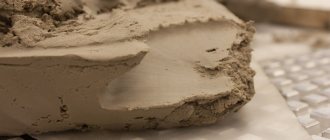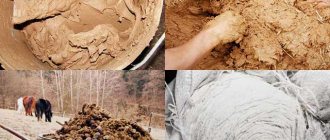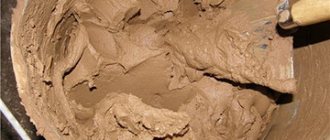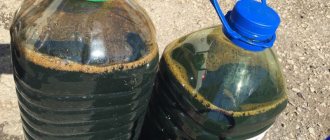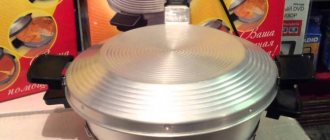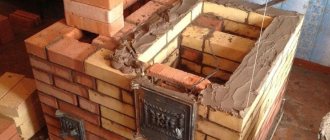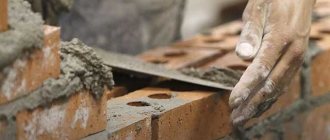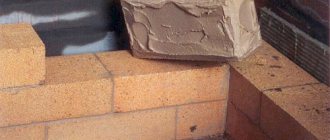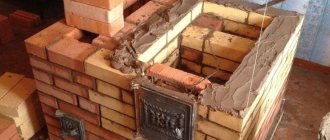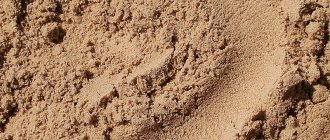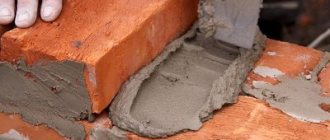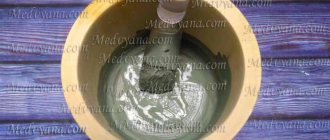Manufacturing recommendations
Construction stores sell ready-packed mixtures for masonry.
They consist of high quality clay mixed with fine sand. To make masonry mortar with your own hands, you have to take sand and clay from the area. Stove makers sometimes use several types of raw materials from different areas. In order not to make a mistake and not to bring the wrong material, it is useful to consult with local craftsmen.
Which clay to choose and how to determine its quality
Clay is a finely dispersed rock with a particle size of thousandths of a millimeter. The chemical formula of the bulk of the rock is Al2O3. This material is very plastic, susceptible to mechanical stress, clay paste will withstand the thinnest modeling. The volume of raw materials swollen with water increases up to two times.
The composition of clays includes oxides of iron and other metals, plant residues, hydrocarbons, carbonates, chalk particles, and iron sulfide. Impurities give this rock its different colors.
Fatty clays are finely dispersed and highly plastic. When dried, the raw material cracks greatly, although the dried pieces are highly durable. Such rocks contain from 3 to 15% sand.
Lean (sand-enriched) clays, on the contrary, have low plasticity. When dried, they become fragile, destroyed due to the high content of granular material and are close in composition to sandy loam. They contain more than 80% sand.
Clays of normal (medium) composition do not crack after drying and do not crumble under mechanical stress.
The quality of raw materials is determined experimentally. There are several ways to determine the fat content of clays:
Method 1. From clay that was soaked a day ago, roll sausages up to one and a half millimeters thick and up to 20-22 cm long. They wrap them around a cylindrical object with a circumference of about 50 cm.
Oily, viscous clay stretches smoothly and easily without breaking. When the raw material has a normal composition, small cracks will appear on the flagellum due to stretching. A rope of thin clay mass will break when stretched.
Method 2. The dry material is filled with water and softened to a liquid dough. The soaked mass is stirred with a wooden spatula and lifted up. Oily, viscous clay forms a layer on the blade that strongly adheres to the wood. Normal clay falls off the mixer in chunks. Skinny - everything falls off, only moisture remains on the stirrer.
Method 3. Press the newly rolled clay sphere with a plank. If the material has a greasy composition, cracks will appear on the sphere when it is flattened to half its diameter. On raw materials of normal composition, cracks will appear when flattened by a third of the diameter, on thin clays - when slightly flattened.
Method 4. The clay is soaked and kneaded. The amount of water should be small, as for dumplings, elastic dough. A sphere with a diameter of 40-50 mm is rolled out of this material and a cake 25-30 mm thick is made. The samples are dried for a couple of days.
- Oily, plastic clay will develop cracks after drying.
- If the raw material has a normal composition, there will be no cracks.
- On lean clay, saturated with coarse impurities, there will be no cracks, but the ball will be fragile and will crumble under mechanical stress.
If a ball is dropped from a meter high, oily (and normal) clay will not break. A ball molded from thin clay saturated with coarse fraction will break into many pieces and grains of sand.
What sand to prepare
Only fine sand with a grain diameter of up to 1.5 millimeters is added to the clay solution. Sand of a mixed composition (quartz, feldspars, pieces of other minerals, mica) or pure quartz sand is suitable for masonry.
Preparation of the solution
It’s worth saying right away that no one can name the exact proportions of the components; accordingly, they will need to be determined independently. The difficulty is that initially the clay already contains sand, hence the distribution of the material. It can be fat (if there is a lot of sand) and skinny (if there is little sand). On average, the proportions range from 1:2 to 1:5 volume.
Preparing the composition
To mix a medium-fat solution with your own hands, do the following:
- We take a construction bucket and fill a third of its volume with clay.
- Then add sand to the remaining volume until it is completely filled.
- Mix thoroughly, adding water if necessary.
- We check the thickness of the solution (the mixture should not fall off the spatula if it is turned down, but if placed vertically, it will flow smoothly).
When the solution is prepared accordingly, this ratio of clay and sand must be remembered in order to know in the future how much and what to use. If the fireclay solution falls off the spatula, you should add more clay and check the density again, and when it does not flow down vertically, then you should add sand.
It is important to mix the correct mortar, because if it is greasy, then when it dries, the structure will become covered with cracks, but if you mix a thin mixture, the masonry will not be strong.
Good to know: Which varnish to choose for covering a brick oven and how to use it
Advantages and disadvantages
Fireclay material has certain advantages that you need to know about if you want to work with it:
- clay has a high heat resistance;
- good adhesion of the material allows for excellent adhesion to the surface of any material;
- the vapor permeability indicator allows the solution to pass wet vapors through its layer, accumulate them inside and, if necessary, return them again, regulating air exchange;
- long operational period. Fireclay clay does not crack on its surface for a long time, is resistant to crumbling, and does not change its initial parameters and shape for many years;
- This environmentally friendly material does not pose any danger to the human body.
It's fair to say. That with all its advantages, fireclay clay has certain negative qualities:
- it is difficult for novice craftsmen to mix a high-quality solution;
- the cost of clay is high, which distinguishes it from simple types of clay.
Sometimes it is impossible to complete a particular construction task using traditional materials. There are situations where some designs require a high level of heat resistance. In such cases, they use a special building material - fireclay clay, the uniqueness of which is determined by the technological manufacturing features that give the material resistance to high temperature conditions.
It should be noted that in order to successfully solve construction problems, the preparation of a solution from fireclay clay must be carried out in accordance with the instructions. In addition, it is recommended to adhere to the correct proportions; prepare the fireclay clay solution in small quantities, as it hardens quickly.
Advantages of refractory clay
Among the advantages of this building material the following are noted:
- Long service life. The solution does not crack, does not crumble, and retains its original shape.
- Has excellent adhesive properties. Grips well on any surface.
- Vapor permeability.
- Resistance to various temperatures.
- Clay is an environmentally friendly and completely safe product.
Factory heat-resistant mixtures
In ready-made oven mixtures, all the above procedures have already been done at the factory. There is no need to look for the right proportion of sand and clay. Most heat-resistant mixtures are simply filled with water and mixed. You don’t have to select the amount of water either: it is indicated on the package. Experienced stove makers may not need such mixtures, but for a beginner, when laying a stove with their own hands, a heat-resistant mixture will be useful. The main disadvantage of using a heat-resistant mixture is the higher overall cost of building the stove.
A significant advantage of ready-made mixtures is the presence in their composition of ingredients that are usually not used when preparing masonry mortar with your own hands. Such components include plasticizers and fireclay chips.
Ready-made oven mixtures based on crushed refractory ingredients are called mortars. They are divided into fireclay, semi-acid, mullite and mullite-corundum. When laying home stoves, only fireclay mixtures are used. The rest are used in the production of blast furnaces, cupola furnaces, hog furnaces, etc. Let us dwell in more detail on fireclay mixtures.
Fireclay is a fireproof material that is obtained by firing fireclay clay. The material is exposed to high temperatures until it completely loses its plasticity and moisture. After this, the fireclay is ground into powder, mixed with various types of clay, to obtain different heat-resistant mixtures. Mortars are classified as thermo-hardening, that is, they acquire their fire-resistant properties only after high-temperature firing.
| The brand of the mixture is designated by the letter M, the letter Ш stands for “fireclay.” The number in the marking indicates the size of the proportion of aluminum oxide (Al2O3) in the composition, and, accordingly, the fire-resistant properties of the material. Grades MSh 39 and MSh 36 have a fire resistance of at least 1730 degrees, MSh 31 - 1690 MSh 28 - 1650. |
For all their advantages, ready-made mixtures also have certain limitations. Many mixtures do not provide for re-mixing unless the entire supply of solution has been used up. Masonry cannot be carried out at sub-zero temperatures. The solution from the finished mixture will take longer to dry due to the addition of plasticizers. The prepared mixture must be worked out in one go. Manual kneading of many heat-resistant oven mixtures is impossible; you will need to acquire a special mixer.
What is fireclay clay
Fireclay is the most environmentally friendly refractory raw material. Before you figure out how to work with it, you need to find out what this building material is and what advantages and disadvantages it has.
Fire clay consists of elements such as quartz, alumina ceramic, calcium oxide, iron oxide, sodium oxide and magnesium oxide
What does it consist of and what does it look like?
The primary basis of fireclay is kaolin clay, which is formed as a result of the settling of particles of destroyed rocks. A mass of gray kaolin clay is subjected to heat treatment at high temperatures - about 1300-1500 Co, as a result of which it loses almost all the water that holds its molecules together, and the clay sinteres. After this treatment, kaolin acquires a brown tint and, in terms of physical properties, becomes similar to stone. Fireclay is brought into its finished form using metal rollers, which crush pieces of burnt kaolin.
The higher the firing temperature of kaolin clay, the less water remains in the fireclay composition, due to which the material loses its plasticity and does not undergo dramatic physical and chemical changes when exposed to heat. In other words, due to the loss of water, fireclay practically does not expand when heated. Based on moisture absorption, fireclay is divided into:
- Highly annealed. Water absorption – from 2 to 8%.
- Low-burnt. Water absorption – from 20 to 25%.
All types of fireclay clay can withstand approximately the same temperature, at which they are not subject to its destructive effects - 1800 Co. The maintained temperature depends on the final material in which the fireclay powder was used: the concentration of clay, water, retaining agents and other chemical reagents in it. Manufacturers may (but are not required to) list the exact maximum operating temperature of the clay on the bag, along with detailed mixing ingredients.
Fireclay clay is excellent for laying fireclay bricks, since both materials have the same coefficient of linear expansion
Clay also has another characteristic - moisture. The higher it is, the more plastic the material is, and therefore the more sensitive to thermal effects. Humidity, as well as the maximum temperature, may be indicated on the packaging, but usually this characteristic is not paid attention to, since the difference is small - from 4 to 7%. In addition, fireclay differs in particle size: fine-grained is used for adding to bricks, and coarse-grained is used for decorative finishing.
What is it for?
Fireclay clay is a material with a wide range of uses. Its thermal resistance is especially valued in construction, and its beautiful brown color and unusual texture are valued in interior design and artistic modeling. The main areas of application of fireclay are:
- Creation of fire-resistant building materials;
- Decorating the room using fireclay plaster;
- Modeling of figurines and souvenirs from fireclay mass with special impurities.
Fireclay brick is fireproof and is marked with the letter “Ш”
Fireclay powder is added to cement mixtures, putty, and can also be used as a base for bricks. As a result, such a product acquires fire-resistant properties, but its price also increases significantly. Refractory bricks (“Ш” - such a marking must be present on them) are capable of withstanding one and a half thousand degrees, thanks to which they serve as the main material for furnaces, but it makes no sense to lay out the entire structure from them, since it will cost a pretty penny
It is important to note that for fireboxes it is necessary to use not only refractory bricks, but also fireclay mortar to connect them
Due to its texture, fireclay plaster is suitable for modern interior design as an independent artistic tool - you can see that it is used not only to remove unevenness, but also simply to decorate the surface.
Ceramic dishes and decorative figurines are made from fireclay clay.
If you add additives to fireclay clay, including water, moisture-retaining reagents and plasticizers, it will become a pliable material for hand modeling. From such a mixture you can sculpt not only a figurine or decorative figurine, but also artistically design a frame or a small piece of furniture that can be fired in a kiln. The higher the baking temperature, the darker and more fragile the shapes are. After baking, they can be glazed and painted.
Plastering process
Stoves and fireplaces are structures that are constantly exposed to intense heat, so it is very important to choose the appropriate material. Firebricks made from fireclay clay are excellent for this application.
When buying bricks of this type, you should pay attention to the marking, which should contain the letter “Ш”
To obtain a perfectly flat surface, you should use the rule. It is fixed across the vertical profiles so as to achieve simultaneous contact of all beacons horizontally.
When installing beacons, you should also pay attention to the level of extension of the furnace door and the blower. The level of the profiles and doors must match so that the surface is smooth, without protrusions and depressions. Preparing mortars for laying stoves and fireplaces, plaster for decorating premises is in many ways similar to mixing conventional compositions
Application to the surface is also carried out using the same tools, namely two spatulas: with one tool the solution is placed on the surface and leveled, with the other to remove smudges. Other recipes are used to produce building ceramics and modeling compounds. But the general principle is this:
Preparing mortars for laying stoves and fireplaces, and plaster for decorating premises is in many ways similar to mixing conventional compounds. Application to the surface is also carried out using the same tools, namely two spatulas: with one tool the solution is placed on the surface and leveled, with the other to remove smudges. Other recipes are used to produce building ceramics and modeling compounds. But the general principle is this:
- the contents of the package are poured into the container;
- the powder is filled with a certain amount of water;
- swelling of the powder continues for 3 days;
- on the 4th day water is added, in some cases sand, in others additives;
- the mixture is stirred until smooth.
Mixing the solution
Before starting work, you need to decide which part of the heating device you will fold at one time. You need to cook a strictly defined portion. Calculations are made as follows. Each brick requires approximately 1 kilogram of mortar. Therefore, to lay 30 bricks you will need to mix the mixture from a standard 2 kg bag.
If 1 cubic meter is used at a time, 5 packages will be required. The work is carried out according to a standard scheme using quartz sand. The proportion of clay and sand for a large oven is one to three, respectively, for a small hearth – one to two. If you are using a ready-made product from a store, quartz filler will not be required. Process Features:
- sand and clay or the finished product is poured into a container;
- water is also added there, it saturates the powder, when it is completely wet, another liquid is added, its surface should be at a distance of one phalanx of a finger from the wet mixture;
- the mixture settles for up to 3 days;
- on the 4th, stir the solution with a construction mixer until homemade sour cream becomes thick; if it is dry, add water; if liquid, add powder;
- Having achieved the desired density and uniformity, you can begin work.
The technology of laying on fireclay clay does not differ from the usual technique. Experienced masters of masonry heating devices recommend making seams no thicker than 1 centimeter. The structure must dry completely, this will last from 2 days depending on the temperature and humidity. Experienced craftsmen believe that a folded stove contains at least one barrel of water.
To completely evaporate it, after the outer layer has dried, the device needs to be heated little by little 2 times a day with a small armful of firewood. In summer, this procedure lasts from 5 to 10 days, in winter – up to three weeks. Until the stove is completely dry, you cannot heat it to heat the premises. It is also worth understanding that heating structures are not only a source of comfort in the home, but also danger. If the master is not confident in his knowledge, it is better to use the services of professionals.
Construction of furnaces
The production of ceramics from refractory clay can be done in two ways: with firing and without this process. But work begins with preparing the solution:
- fireclay and ordinary clay are placed in the container in a ratio of six to four, respectively;
- materials are filled with water and left for several days;
- the solution is thoroughly mixed with a mixer to a thick consistency - for castings;
- the material is poured into molds and dries for several days, depending on the size and geometry; PVA glue can be used to speed it up;
- the frozen mass is removed from the mold and modified according to the design.
Garden decor made of fireproof clay
Areas of use and formulation of compositions
Due to its good technical characteristics and long service life, refractory clay is widely used for the preparation of plaster and masonry mortars, the production of heat-resistant bricks, the production of ceramics and decorative interior elements.
This material is excellent for making dishes, figurines, sculptures and souvenirs.
The high strength and fire safety of chamotte allow it to be used for decorative finishing of heating stoves, fireplaces and building facades.
Fireproof masonry of heating devices
Experienced stove makers use heat-resistant silicate bricks when building and repairing stoves and fireplaces. In this case, the masonry is done using a special mortar based on refractory clay, which has the same thermal expansion coefficients as brick.
If a standard brick with a low level of voids is used for masonry, then the consumption rate of the material will be 100 kg of fireclay mixture per 1 cubic meter of brick.
Instructions for mixing masonry mortar:
- Components are poured into the bottom of the container in the following proportions: 2 parts quartz sand and 1 part crushed fireclay clay.
- Next, water is added to saturate the dry mixture. Everything is thoroughly mixed and left for 3 days until the liquid is completely absorbed.
- Using a construction mixer, the mortar is mixed to obtain a thick, viscous mixture. Formulations that are too liquid can be thickened with some quartz sand, and thick ones can be diluted with water.
A more complex recipe involves the use of the following components: 1 part blue clay, 1 part fireclay clay and 4 parts white kaolin sand. The mixture is diluted with water to obtain a viscous solution. The finished composition has high strength and fire resistance, reaching 1840 degrees.
To improve performance characteristics, binder components should be added to the finished solution:
- PVA glue.
- Rock salt.
- Liquid fiberglass.
The technology for applying the mortar is similar to that used for laying walls and foundations. The optimal thickness of the joints between bricks is from 8 to 10 mm.
Plastering surfaces
The method of plastering with fireclay clay is similar to the process of applying conventional plaster. The only difference is the recipe for preparing homemade plaster mortar.
It consists of the following components:
- 1 part Portland cement.
- 2 parts fireclay clay.
- 7 parts quarry sand.
A high-quality solution can be prepared as follows:
- Clay and sand should be poured into the container in the specified proportions.
- The dry mixture should be diluted with water and left for a couple of days.
- Add Portland cement to the prepared base and mix thoroughly using a construction mixer until a viscous and uniform mass is obtained.
Important! The finished composition can be used within 2-3 hours before it begins to harden.
The application of the plaster composition is carried out on the previously prepared surface of the heating device. Since firing leads to a decrease in the ductility of fireclay, it is therefore necessary to ensure its maximum adhesion to the surface.
This involves the use of a special heat-resistant deep penetration primer. In the future, a reinforced metal mesh can be glued to the primed surface to increase the adhesion of the plaster composition.
For plastering stoves and fireplaces, two types of spatulas are used - medium and large. The solution must be carefully applied and evenly distributed on the surface with a spatula, promptly eliminating all drips and unevenness. The optimal thickness of the plaster layer is 2 mm.
Decorative finishing is applied after the fireclay plaster has completely dried.
How to dilute fireclay clay for a stove
Preparing a solution from fireclay is considered a difficult task, so it is important to approach this matter carefully, since a properly prepared mixture is the key to a reliable and durable design
Cooking steps
In order for the resulting chamotte solution to have all the declared positive qualities, it is necessary to strictly follow all the rules for its preparation. To do this, you should adhere to the following algorithm of actions:
- The clay is poured into a container in which mixing will be done.
- An admixture is laid out on top: fireclay or quartz sand. There should be proportionally more of them than crushed clay by 2–5 times.
- The dry mixture is poured with water on top.
- Mix everything with a spatula, construction mixer or drill with a special attachment until a homogeneous mass is obtained.
- The container is tightly closed and left for three days. It is necessary to close it so that the liquid does not leave the container.
- At the end of the soaking period, the mixture is thoroughly mixed again, after which you can begin to work.
If you neglect to properly prepare the solution, you may end up with an indigestible mass that is unlikely to be suitable for any construction work. In order not to waste the material, strictly follow the specified algorithm - this will allow you to get a solution that will last a long time in your furnace masonry.
What to do if the clay solution has dried out or turned out to be the wrong consistency
Unfortunately, even a professional layer cannot avoid such incidents, when the solution is of the wrong consistency. The proportions of crushed stone, sand and water are often selected by eye, and when the clay swells for three days, its condition can change in different ways: due to differences in temperature, humidity and similar nuances, which are difficult to influence in non-laboratory conditions.
The ideal consistency of diluted fireclay clay should resemble thick sour cream and not include lumps. If the solution does not satisfy this requirement, then you should analyze the situation and come to an appropriate solution.
If there is a lack of moisture, add water. The presence of a sufficient amount of water directly affects the plasticity of the mixture and its adhesion. If the moisture content is low, the mixture will not apply well and will crack.
If the solution turns out to be too liquid, then sand should be added to it. There is no need to leave the mixture for a few more days.
How to choose a good fireclay brick
The composition of fireclay bricks, its size and porosity are the main characteristics, but it is also important to choose a high-quality material made. Everything may look beautiful on paper, but in practice, an incorrectly made brick will cause problems.
When choosing, you need to pay attention to:
Appearance. The brick should be of a uniform shade, without obvious transitions between light and dark areas. The surfaces of the SB should be smooth, but without a film formed due to long-term storage in the oven. Of course, any chips, cracks and other obvious damage are also undesirable;
Only smooth and hard brick will be of high quality. Source izkirpicha.com
Sound. Helps identify internal damage. When colliding with a steel object, a clear sound should occur without unnecessary vibrations;
Sectional view. The outer part of the brick should have a more saturated color than the inner one. If the material has a dark core, there is a danger that the brick was burned in the oven.
Technical specifications
When purchasing fireclay clay, you need to pay attention to the shelf life of the material. It is also important that the seller stores it in suitable conditions. Deteriorate the properties of the material:
- wet air;
- long-term storage;
- water access.
The shelf life of the material is 3 years if it is stored in a dry place and the integrity of the original packaging has not been compromised. What parameters should high-quality clay have:
- inclusion sizes are around 2 mm;
- moisture absorption rates - from 2 to 10% for high-burnt, and up to 20% for low-burnt;
- humidity - no more than 5%;
- fireproof rating - up to 1850 degrees.
The main advantages of clay with refractory properties include its ability to withstand high temperatures. It also has good adhesion characteristics and vapor permeability. Other advantages include:
- long service life;
- environmental friendliness;
- reliability.
The downside is the high cost when compared with similar types of clays.
A standard package, which includes 20 kg of kaolin, is enough to lay 25 bricks. About 100 kg of fired fireclay should be consumed per cubic meter.
Advantages of refractory
Heat-resistant, fire-resistant fireclay clay has been known to man for several thousand years. Since then, its scope has changed little. Among other natural materials with the same properties, this refractory was chosen due to the following advantages:
- coatings and products made from it do not collapse, do not crack, retain their original shape, and are characterized by a long service life;
- environmentally friendly natural sedimentary rock does not harm human health and the environment;
- clay has high adhesive qualities, it adheres perfectly to metal, stone, brick and other surfaces;
- products and coatings are able to withstand heat stably and for a long time;
- the material is vapor permeable.
Varieties
Features of the technology
Fireclay is formed by any means of plastic molding: modeling, stuffing into plaster molds. If you have experience, you can mold products on a pottery wheel. Single firing is preferable: the dried product is decorated and (or) glazed and fired at a time at a temperature of 1150-1250°C. At firing temperatures above 1200°C there is a good chance of obtaining frost-resistant products. To obtain a good quality glaze coating, it is necessary to carefully smooth the surface of the product immediately after molding or completely engobe the raw material. A long dry firing at a temperature of at least 900°C helps to subsequently obtain a good quality glaze surface.
The procedure for preparing chamotte plaster for finishing and decoration
The plaster is prepared a little differently:
- refractory and sand are poured into the container in a ratio of two to seven, respectively, only fine-grained sand is used, the proportion is strictly maintained, otherwise there is a risk of cracking;
- the powder is poured with water and left for three days;
- Portland cement is poured into the swollen solution in a proportion of one to two parts of clay;
- stir the material with a construction mixer.
It is important to use the entire volume of plaster within the shortest possible time. Further, the solution loses its technological qualities
If work is planned for several days in a row, then a new portion of plaster is prepared every day. In addition to the above ingredients, you can use others:
- the addition of PVA glue will ensure eradicated drying; under natural conditions, the finishing layer based on fireclay releases moisture within two days;
- liquid fiberglass will provide additional plasticity to the mass and strength;
- Rock salt will add strength and speed up drying.
Interior decoration with fireclay refractory in retro style
What is fireclay clay?
Fireclay clay is essentially burnt kaolin, which is usually called fireclay. Kaolin is one of the types of rocks that has high viscosity and plasticity. In addition to the main element, it may contain impurities in the form of oxides of potassium, calcium, magnesium and sodium, hydroxides of iron and titanium, as well as numerous sulfides.
For use, kaolin is fired at temperatures of about 1500 degrees Celsius, which allows the mineral to be rid of unbound water content. This procedure, in essence, produces finished fireclay. Impurities are removed both during the firing process and during further enrichment.
Heating kaolin to such high temperatures reduces the output ductility of fireclay, but at the same time it acquires its main feature - high fire resistance. Such fireclay is subsequently crushed for further use both to a dispersed state (sand) and to small pieces (crushed stone)
According to processing technology, fireclay is divided into two types:
- highly polished;
- low annealed.
They differ from each other in the percentage of water absorption: it is lower at higher annealing temperatures.
